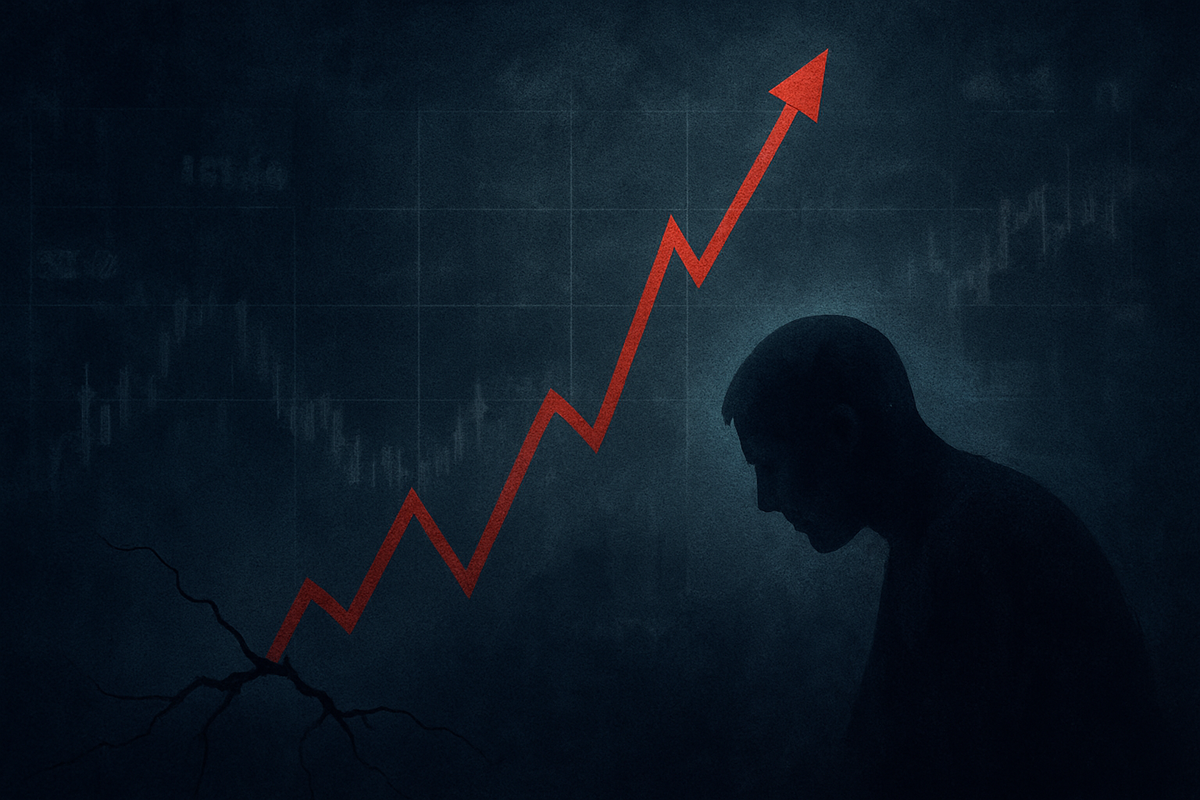
The financial markets are currently gripped by a palpable sense of unease, as evidenced by a significant surge in the Cboe Volatility Index (VIX), commonly known as the stock market's "fear gauge." This sudden spike, particularly pronounced around November 21, 2025, serves as a stark barometer of escalating investor panic and signals a period of heightened market uncertainty. The VIX's ascent reflects a collective bracing for increased market turbulence and potentially larger price swings, sending ripples of concern across global equities.
This alarming movement in the VIX indicates that investors are rapidly shedding their risk appetite, shifting towards safer assets and prompting sell-offs in riskier holdings like stocks. The immediate implication is a period of increased market instability, with major indices facing downward pressure as participants prepare for a more volatile trading environment. This "November Shock" suggests that the market's recent bullish run may be giving way to a more cautious, if not outright fearful, outlook.
The Anatomy of a November Shock: Unpacking the VIX's Ascent
The recent surge in the VIX has been both rapid and dramatic. On November 21, 2025, the index had already jumped 50% for the month, closing at 26.3 levels on November 20 after an 11.4% daily increase. Earlier in the week, it spiked to 26.20 and briefly touched an intraday high of 28.27. More strikingly, on November 18, 2025, the VIX surged to an intra-day high of 52.87, settling at 48.35 by market close – marking over a 150% increase from its opening levels. These figures represent a significant leap from the 17-19 range observed earlier in the month, with the United States Federal Reserve reporting the VIX at 24.69 for November 2025.
This "November Shock" is not an isolated event but rather the culmination of several intertwining factors. A prolonged rally in the S&P 500 (SPX), which saw the index surge 42% from its April low to late October high, fueled by enthusiasm for artificial intelligence and two consecutive interest rate cuts by the Federal Reserve (FED) in September and October, led to growing concerns over stretched equity valuations, particularly among U.S. tech giants. Many investors and analysts began to question the sustainability of such rapid growth, creating a fertile ground for a sentiment reversal.
Market uncertainty was further amplified around November 20 following the earnings report from Nvidia (NASDAQ: NVDA). While the initial reaction sent the Nasdaq Composite (NASDAQ) higher, the tech-heavy index later reversed course and traded lower, signaling a broader risk-off sentiment permeating the market. This swift turnaround after a key earnings report from a bellwether tech company underscored the fragility of investor confidence.
Adding to the domestic concerns, renewed geopolitical instability, specifically recent U.S. military actions in the Middle East and the uncertainty surrounding potential Iranian retaliation, has significantly fueled heightened investor anxiety. Furthermore, persistent inflation data earlier in November dampened hopes for aggressive central bank rate cuts, further unsettling the market and contributing to investor unease regarding future monetary policy. These combined pressures have created a perfect storm for the VIX to surge, reflecting a market grappling with multiple layers of risk.
Winners and Losers in a Volatile Landscape
The surge in the VIX index and the accompanying rise in market volatility inevitably create a dichotomy of winners and losers across the corporate landscape. This environment fosters a "flight to safety," where investors rotate out of high-risk, high-growth assets into more stable, defensive holdings, significantly impacting various sectors and company types.
Companies heavily reliant on future growth expectations, particularly in the technology sector, are among the most vulnerable. Their valuations, often predicated on aggressive projections and high multiples, suffer as investors prioritize immediate profitability over speculative future growth. Rising interest rates, a common response to inflation or economic instability, further discount future earnings, making these growth stocks less appealing. Tech giants such as Apple (NASDAQ: AAPL), Microsoft (NASDAQ: MSFT), Amazon (NASDAQ: AMZN), Tesla (NASDAQ: TSLA), and Nvidia (NASDAQ: NVDA), which have previously propelled market rallies, can experience sharper corrections during such downturns. Nvidia, for instance, saw a notable drop despite strong earnings, fueled by concerns over stretched valuations and the potential for an "AI bubble." Similarly, highly leveraged firms and small and medium-sized enterprises (SMEs) face significant headwinds, as access to capital becomes more expensive and lenders grow more cautious. Cyclical industries, sensitive to economic slowdowns, and companies with significant international exposure, which face exacerbated currency fluctuations, also typically underperform.
Conversely, defensive sectors tend to emerge as relative winners or, at the very least, demonstrate greater resilience. These sectors provide essential goods and services, ensuring more stable earnings and dividends even during economic turbulence. Healthcare, for instance, acts as a defensive anchor due to non-cyclical demand driven by essential medical needs and an aging population. Established, large-cap pharmaceutical and medical device giants like AstraZeneca (LSE: AZN) often see stable performance. Consumer staples, encompassing everyday necessities, and utilities, which provide predictable cash flows, also become attractive havens for risk-averse investors.
Interestingly, the trading divisions of major financial institutions can sometimes benefit from increased volatility. Large banks and brokers like Goldman Sachs (NYSE: GS), JPMorgan Chase (NYSE: JPM), and Morgan Stanley (NYSE: MS) can see a boost in revenues from wider bid-offer spreads and increased trading volumes as investors rebalance portfolios and engage in hedging activities. Companies with robust balance sheets, ample cash reserves, and manageable debt are also better positioned to weather economic storms, focusing on operational efficiency and potentially seizing opportunities to acquire assets at reduced valuations. Furthermore, specialized financial products, such as Exchange-Traded Funds (ETFs) and Exchange-Traded Notes (ETNs) that track or inversely track the VIX (e.g., VXX, VIXY, UVXY, SVXY), see increased interest from sophisticated investors looking to hedge portfolios or capitalize on market movements.
Broader Implications: A Shifting Economic and Geopolitical Landscape
The VIX spike in November 2025 is more than just a momentary blip; it signals profound shifts within broader industry trends and carries significant ripple effects across the global economy. This surge is unfolding against a backdrop of "risk-off" sentiment, marking a potential departure from a prolonged era of low interest rates and stable growth, forcing a re-evaluation of market fundamentals and strategic approaches.
At its core, the VIX's ascent is deeply intertwined with prevailing geopolitical and economic uncertainties. Recent U.S. military actions and the looming threat of Iranian retaliation, alongside ongoing conflicts like the Russia-Ukraine war, are primary catalysts, fueling concerns about supply chain disruptions, particularly in crucial commodity markets like oil. Economically, persistent inflation, coupled with cautious monetary policies from central banks and subdued global growth projections for 2025, creates a challenging environment. Mixed U.S. employment data and an ongoing federal government shutdown further exacerbate anxiety, leading investors to scrutinize asset prices and question the sustainability of current stock valuations, especially within the potentially overvalued technology and artificial intelligence (AI) sectors.
The ripple effects extend across competitors and partners. Companies heavily reliant on discretionary consumer spending, those with substantial debt, or business models demanding aggressive, continuous growth will face significant challenges. E-commerce giants and their logistics partners, for instance, may see a negative impact from reduced consumer confidence and spending. Supply chains are particularly vulnerable to geopolitical tensions and uncertain global tariff policies, compelling companies to re-evaluate sourcing strategies through nearshoring or regionalization. This demands substantial investment and coordination with new partners, disproportionately affecting small and mid-sized businesses. Furthermore, companies dependent on stable capital markets for financing or expansion may find it harder to secure funds or face higher borrowing costs, potentially slowing down mergers and acquisitions activity. Conversely, defensive sectors, such as healthcare, and market infrastructure providers like Cboe Global Markets (CBOE: CBOE), the operator of the VIX index, may see increased activity and benefit from heightened trading volumes.
From a regulatory and policy perspective, VIX spikes are closely monitored by central banks and financial authorities. A sustained period of high volatility can signal systemic risks, potentially prompting central banks to consider responses like slowing rate hikes, implementing liquidity injections, or pausing quantitative tightening. The VIX surge during the 2018 market plunge, for example, led to a dovish pivot by the Federal Reserve. A prolonged period of market turbulence could also instigate discussions around enhanced market stability mechanisms and investor protection measures. Moreover, the VIX, when analyzed in conjunction with the yield curve, provides policymakers with a richer, real-time picture for gauging economic turning points, making its current elevated state a critical indicator for future monetary policy adjustments.
Historically, the VIX has proven to be a reliable barometer of market stress. Previous spikes above 25 have consistently coincided with significant market events, including the 2008 financial crisis, the 2020 pandemic sell-off, and the 2022 invasion of Ukraine. The all-time highest VIX closes of 82.69 in March 2020 and 80.86 in November 2008 underscore its role during periods of extreme market duress. While the VIX shows modest increases as an economy enters a recession, significant spikes often occur later in the economic adjustment process, offering a crucial, if lagging, signal. However, historical data also suggests that after the VIX spikes above 60 (intraday), the market tends to increase 65% of the time one month later, with average gains outweighing losses, hinting at a potential for recovery after the initial shock. This November 2025 surge, therefore, is not merely a reflection of immediate jitters but a deeper re-evaluation of economic stability and geopolitical risks, demanding strategic foresight from investors and vigilant monitoring from policymakers.
What Comes Next: Navigating the Path Ahead
The significant VIX spike in November 2025 ushers in a period demanding careful navigation from both companies and investors, presenting both formidable challenges and nascent opportunities. While the immediate aftermath is likely to be characterized by continued market sensitivity and potential drops, historical precedents suggest a complex interplay between short-term turbulence and long-term recovery.
In the short term, markets are bracing for ongoing uncertainty and heightened risk. The S&P 500 (SPX) has historically struggled for several weeks following VIX spikes above 45, often delivering mixed to negative returns. This period will likely see persistent economic slowdown concerns, potentially eroding consumer and business confidence, and increasing fears of a recession. Liquidity and credit conditions could tighten, making capital more expensive for businesses, while earnings pressure may mount due to reduced consumer spending and supply chain disruptions. Sectors like technology, particularly those with high valuations in Artificial Intelligence, and consumer discretionary, may experience significant downturns as "valuation bubble" fears take hold. Companies will need to prioritize supply chain restructuring for resilience, focus on efficiency and profitability, and strengthen their balance sheets to weather potential economic headwinds.
However, beyond the immediate turmoil, significant VIX spikes have often historically marked long-term buying opportunities. Extreme VIX readings, typically above 40 or 60, have frequently coincided with market bottoms, preceding robust recoveries. Historical data indicates a higher likelihood of positive market returns over one to two years following such spikes, with average 12-month returns often in double digits, exceeding the S&P 500's historical average. This creates "buy the dip" scenarios for patient, long-term investors and opportunities to acquire undervalued assets. Defensive sectors like utilities and healthcare, along with safe-haven assets such as gold, may continue to outperform. A "flight to safety" could also lead to a rotation from high-valuation growth stocks to more stable value stocks, creating opportunities for active managers to identify mispriced securities.
For investors, strategic adaptation is paramount. Short-term strategies might involve hedging with protective put options or utilizing VIX-linked instruments for pure volatility exposure. Long-term investors, however, should resist emotional selling, consider dollar-cost averaging, diversify their portfolios across various asset classes, and focus on companies with robust financials and strong fundamentals. The current extreme fear, as indicated by the high VIX, often presents a contrarian opportunity for long-term gains. Companies, meanwhile, should consider strategic mergers and acquisitions if they possess strong financials, re-evaluate aggressive growth plans, and double down on core competencies.
The future could unfold in several scenarios: a quick "V-shaped" recovery if underlying issues are temporary and policy responses effective; a prolonged "U-shaped" turbulence if deep-seated economic issues or escalating geopolitical tensions persist; or even a fundamental shift to a new market regime characterized by higher sustained volatility. From a contrarian perspective, these extreme VIX spikes can be seen as necessary "flushes" that clear out excess leverage, ultimately creating healthier market conditions for future growth. The actual outcome will hinge on the catalysts behind the November 2025 VIX spike, the effectiveness of central bank and government policy responses, geopolitical developments, and the resilience of corporate earnings.
Wrap-up: Navigating the New Volatility Regime
The recent surge in the VIX index around November 21, 2025, serves as a potent reminder of the inherent risks and rapid shifts possible within global financial markets. This "fear gauge" spike, fueled by a complex interplay of overextended equity valuations, geopolitical instability, and monetary policy uncertainties, has unequivocally signaled a period of heightened investor anxiety and market turbulence. The key takeaway is a clear shift from a bullish, growth-driven environment to one demanding greater caution, resilience, and strategic adaptability.
Moving forward, the market is likely to remain sensitive, with potential for continued choppiness and sector rotations. While the immediate aftermath often brings declines, historical data suggests that extreme VIX readings can also precede robust market recoveries in the medium to long term, offering potential "buy the dip" opportunities for patient investors. However, the trajectory will largely depend on whether the underlying catalysts for this spike prove transient or indicative of deeper, structural issues. A quick, "V-shaped" recovery is possible if policy responses are swift and effective, but a prolonged "U-shaped" turbulence could ensue if economic or geopolitical tensions escalate.
The lasting impact of this VIX surge may include a more cautious investor sentiment, favoring quality and value over speculative growth, and an increased demand for hedging strategies. It also puts central banks and governments on alert, potentially prompting policy interventions if economic fallout is severe. For investors in the coming months, vigilance is paramount. Closely monitor inflation data and central bank commentary for clues on interest rate policy, track key economic growth indicators (GDP, employment reports, consumer confidence), and scrutinize corporate earnings and forward guidance. Geopolitical developments, bond market movements (especially the yield curve), and commodity prices will also be critical indicators to watch as the market seeks to find its footing in this new, more volatile regime.
This content is intended for informational purposes only and is not financial advice




